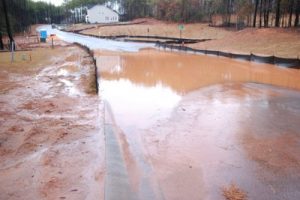Sediment is comprised of particles from soil and other sources that accumulate in rainwater as it drains off of land into streams and bodies of water. As rainwater drains into streams and bodies of water, it gathers particles from soil and other sources into sediment, which is suspended in the water until settles in the beds of rivers and lakes. Sedimentation occurs naturally during most rain events and is beneficial to nutrient cycling under natural conditions. This process has, however, been exacerbated due to a number of human activities.
The construction of roads, parking lots, buildings, and industrial sites means that rainwater is not able to enter the ground as easily, resulting in increased runoff during storms. Additionally, sites of new development often contain large areas of unbound and exposed soil, from which large amounts of sediment enters rainwater as it drains from the land, and involve the removal of existing vegetation. These actions together remove existing, natural sediment filters and erosion control, leading to higher sedimentation in streams and bodies of water.

Additional sources of sedimentation include industrial sites, agriculture, and urban and city stormwater systems. Stormwater poses a unique threat in North Carolina because it is not filtered; instead, current sedimentation regulation aims to reduce the contaminants present at the source of discharge, such as industrial or developmental sites. Ultimately, if not managed properly, these various sources of sedimentation combine to increase the risk of a number of environmental impacts.
As mentioned in Ecology of the Catawba River, the first of these affects filter feeders, a set of organisms that includes one of the endangered species mentioned above: the Carolina Heelsplitter mussels. The Heelsplitter, along with other mussel species, sifts nutrients out of the water through gills. As they filter runoff from roads and developmental sights, harmful compounds accumulate in their systems. When the level of sediment becomes too great, their gills become clogged and cannot filter effectively. In addition to increased mussel mortality, this impairment of the filter feeding population leads to a significant decrease in water quality. Another concern, discussed further in Agricultural Runoff, surrounds nitrates and phosphates in runoff from agricultural sites. These factors are not only directly harmful to filter feeders in excessive amounts, but they also increase the likelihood of algal blooms, which can lead to mortality in or habitat eviction of fish.
In response to the clear ecological danger of sedimentation, the Sedimentation Pollution Control Act of 1973 was passed, which addresses both sedimentation and erosion. The Act includes not only regulations, such mandatory buffer zones and onsite water filtration devices (§ 113A-57), but also enforcement of these regulations (§ 113A-58, § 113A-61.1) and penalties for infractions (§ 113A-64). Enforcement of regulations falls to the North Carolina Sedimentation Control Commission (NCSCC), which was created by the Act, but there is evidence to suggest that the Commission is not entirely successful in controlling sedimentation. Of the 10,234 Sedimentation and Stormwater inspections performed by the Commission in the 2015-2016 fiscal year, there were only 95 reports of violation and only 8 instances of referral for enforcement. Given these numbers, the fact that sedimentation continues to pose a threat to water quality suggests that current sediment filtration techniques are inadequate. Alternatively, it is possible that current techniques fail because they are simply improperly implemented or maintained, rather than being inadequate in themselves. The state of current sedimentation management like falls within both of these scenarios.
In addition to these issues, private residents also intentionally and unintentionally contribute directly to sedimentation. The ways in which they do so individually may seem innocuous or too small to matter, but collectively they represent a notable threat.

Some residents intentionally or unintentionally dispose of yard or other waste in storm drains, which introduces not only additional sediment but also various macro-pollutants. Other residents blow leaves and debris into streams and bodies of water. This debris aggregates on the surface and can disrupt underwater habitats. Clumps of leaves pose a specific threat once they sink, for they create a dense, benthic layer that causes deoxygenation and methane production as it decomposes. This layer can also potentially affect mussels in ways similar excess sediment and can increase the bacterial content of the water, which is a precursor to algal blooms and eutrophication.
Residents also contribute to sedimentation issues indirectly or unintentionally by failing to report developers who appear to be causing damage; though surveys are conducted by the NCSCC, residents have the power to report infractions to local or state bodies, such as the Division of Environmental Management (DEM) or the Department of Environmental and Natural Resources (DENR), or to NGOs, such as the Catawba Riverkeeper Foundation. This situation is most likely attributed to simple ignorance, in that most residents either do not know that sedimentation is a significant issue or that they are able to report it; in either case, it is evident that educating the public on these issues is necessary.
Sources
“Leaves and Lakes.” Catawba Riverkeeper. n.d. Web.
“Sediment and Suspended Sediment.” U.S. Geological Survey. 2 May 2016. Web.
“Sedimentation and Urbanisation.” NIWA. n.d. Web.
“Where Does Water Pollution Come From?” Charlotte-Mecklenburg Storm Water Services. n.d. Web.
